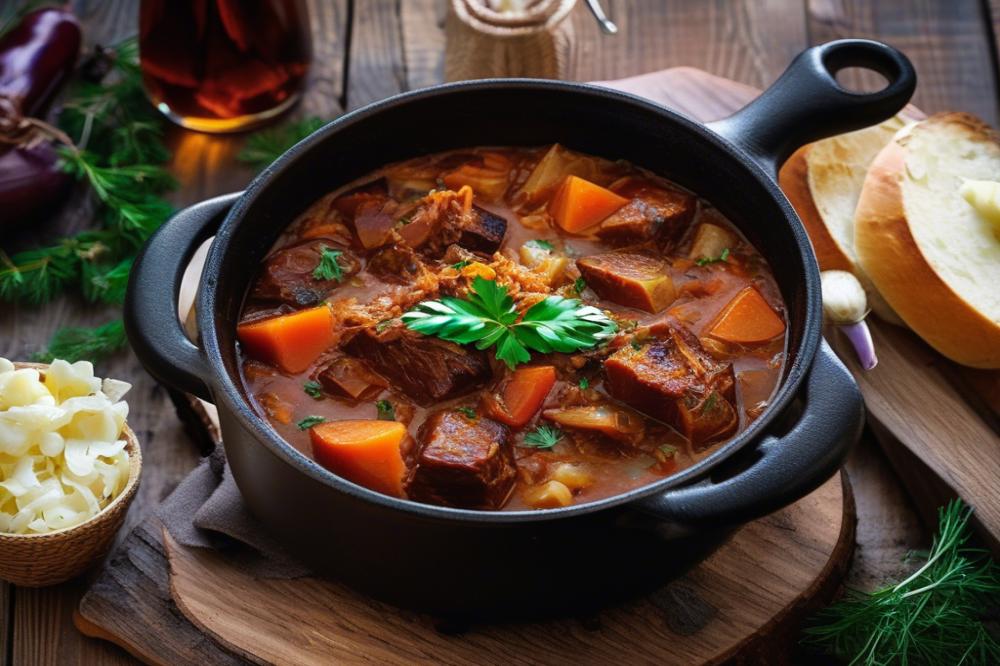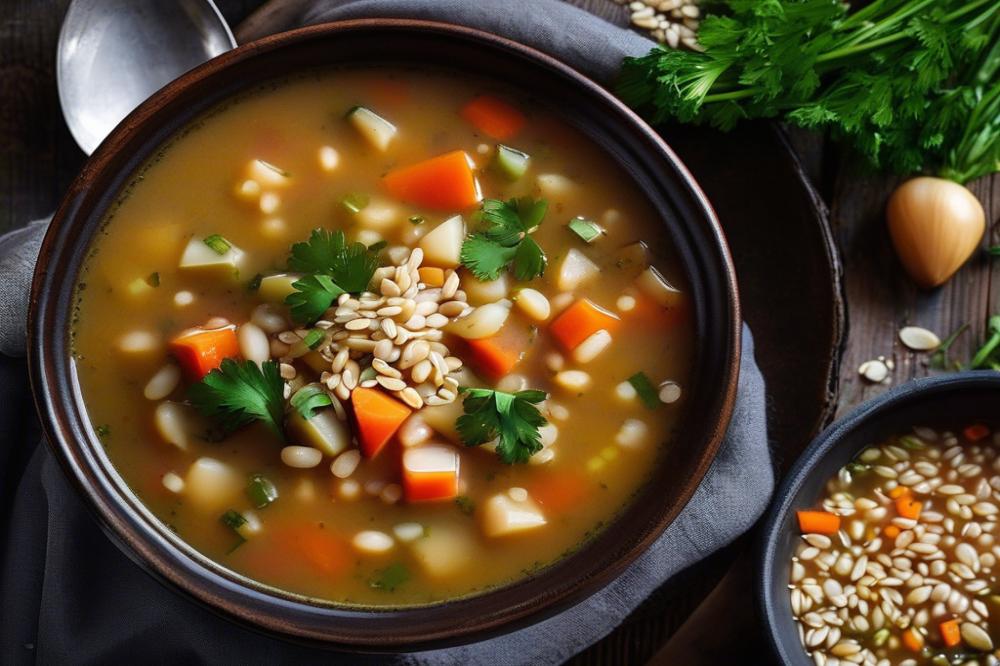Introduction
Polish cuisine is rich with flavors and traditions. Among its many dishes, one stands out as a true staple: Bigos, commonly referred to as hunter’s stew. This hearty meal showcases the best of what Polish cooking has to offer. It combines sauerkraut, various cuts of meat, and a blend of spices that create a deep and satisfying flavor profile.
Traditionally, this Polish stew is more than just food; it’s a symbol of cultural heritage. Many families share stories about their variations of this dish. Passed down through generations, each recipe carries its own unique touch. During cold winter months, this slow-cooked dish warms both body and soul. It embodies comfort food in every sense.
Readers can look forward to exploring a well-rounded recipe for Bigos, as well as its history and significance in Polish culture. Tips for preparation and serving will also be included, making it easy for anyone to try their hand at a beloved classic. So whether you’re familiar with Polish dishes or new to this world, let’s dive into the vibrant flavors of this iconic hunter’s stew.
Bigos: The Heart of Polish Cuisine
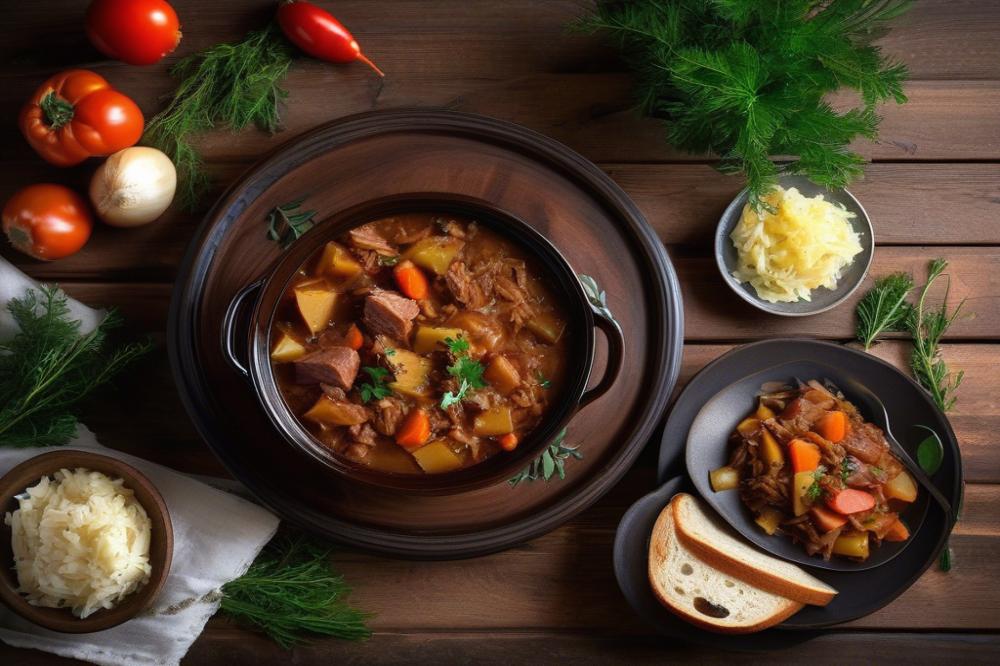
Comfort food can take many forms, but few dishes evoke warmth and satisfaction quite like this traditional hunter’s stew. It blends meat and sauerkraut with an array of other ingredients, creating a rich tapestry of flavors. Many people find solace in hearty meals, especially when the weather turns chilly. This dish is often a staple on Polish tables, bringing both nourishment and nostalgia.
The origins of this stew stretch back centuries, rooted deeply in Polish history. It is said that bigos dates back to the 14th century, with each region adding its spin to the recipe over time. Hunter-gatherers of the past would combine whatever meat they had on hand, making use of the fermented cabbage that could be easily stored. This method ensured that food remained edible through harsh winters, a vital consideration in the days before refrigeration.
Family gatherings and winter festivities often revolve around this beloved meal. During holidays, the cooking process becomes a communal activity, bringing people together in the kitchen. Many families pass down traditional recipes, each claiming their version as the best. Sipping warm bowls of stew while sharing stories strengthens bonds across generations.
As the stew simmers, a comforting aroma fills the home, inviting everyone to the table. Enjoying a plate of this stew is more than just a meal; it is an experience. It connects individuals not just to the food but to their heritage and loved ones. For those who appreciate rich, slow-cooked flavors, this dish stands as a symbol of Polish culture and the heartiness of winter dishes.
Ingredients for Bigos
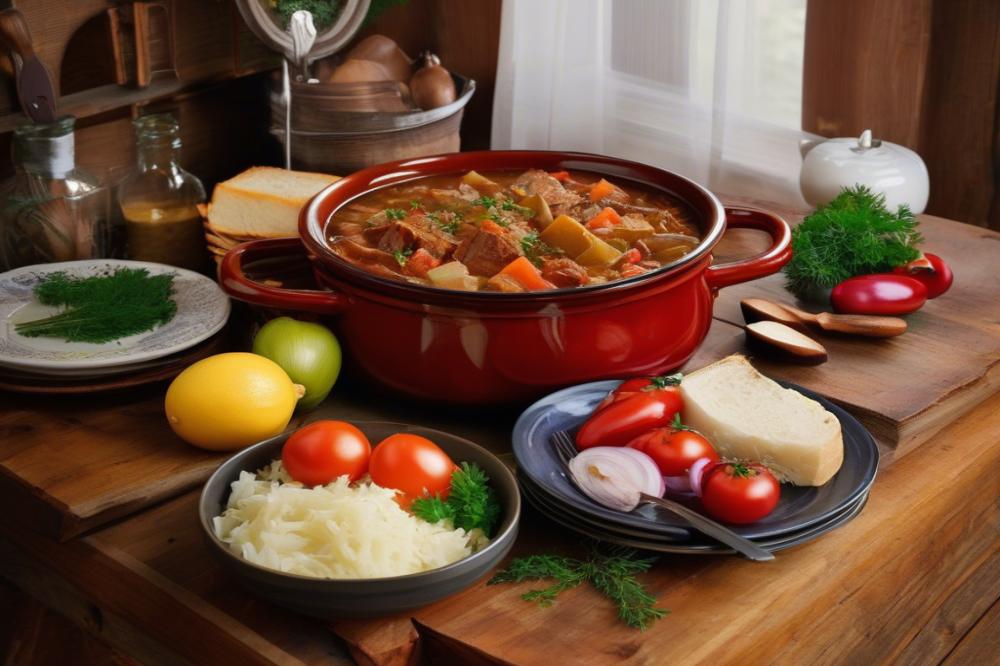
To create a delicious hunter’s stew, gather the following ingredients. Each item contributes to the rich flavors of this traditional Polish dish. Let’s take a closer look at what you’ll need:
- 1 pound smoked sausage
- 1 pound pork shoulder, cubed
- 1 cup beef, cubed
- 1 large onion, chopped
- 2 cloves garlic, minced
- 2 cups sauerkraut
- 2 cups fresh cabbage, chopped
- 1 tablespoon tomato paste
- 1/4 cup red wine (optional)
- 1 tablespoon paprika
- 1 teaspoon black pepper
- 1 bay leaf
- 2 tablespoons vegetable oil
- Salt to taste
Each ingredient plays an important role in flavor development. For instance, smoked sausage provides depth and a savory profile. The pork shoulder adds a tender texture that nicely complements the sauerkraut and cabbage. Together, the meats create a hearty base for your stew.
Nutritional Information
Understanding the nutritional content helps in planning your meals. Here’s a breakdown of what each ingredient offers:
- Smoked sausage (1 pound): 1260 calories, 80g protein, 100g fat, 0g carbohydrates, 0g fiber
- Pork shoulder (1 pound): 880 calories, 92g protein, 52g fat, 0g carbohydrates, 0g fiber
- Beef (1 cup): 450 calories, 42g protein, 30g fat, 0g carbohydrates, 0g fiber
- Onion (1 large): 60 calories, 2g protein, 0g fat, 14g carbohydrates, 3g fiber
- Garlic (2 cloves): 8 calories, 0.4g protein, 0g fat, 2g carbohydrates, 0.1g fiber
- Sauerkraut (2 cups): 60 calories, 4g protein, 0g fat, 14g carbohydrates, 6g fiber
- Fresh cabbage (2 cups): 50 calories, 3g protein, 0g fat, 12g carbohydrates, 5g fiber
- Tomato paste (1 tablespoon): 13 calories, 0.7g protein, 0.2g fat, 3g carbohydrates, 0.5g fiber
- Red wine (1/4 cup): 50 calories, 0.1g protein, 0g fat, 4g carbohydrates, 0g fiber
- Paprika (1 tablespoon): 19 calories, 1g protein, 1g fat, 4g carbohydrates, 2g fiber
- Black pepper (1 teaspoon): 6 calories, 0.2g protein, 0g fat, 1.4g carbohydrates, 0.2g fiber
- Bay leaf (1): < 1 calorie, 0g protein, 0g fat, 0g carbohydrates, 0g fiber
- Vegetable oil (2 tablespoons): 240 calories, 0g protein, 28g fat, 0g carbohydrates, 0g fiber
These values are approximations and may vary based on preparation and specific products used. Comfort food like this is rich in flavors and nutrients. The combination of meats and fermented cabbage makes for a filling dish that’s perfect for winter meals. Enjoy the process of slow-cooking as you watch the melding of these ingredients into a delightful stew.
Cooking Instructions for Traditional Bigos
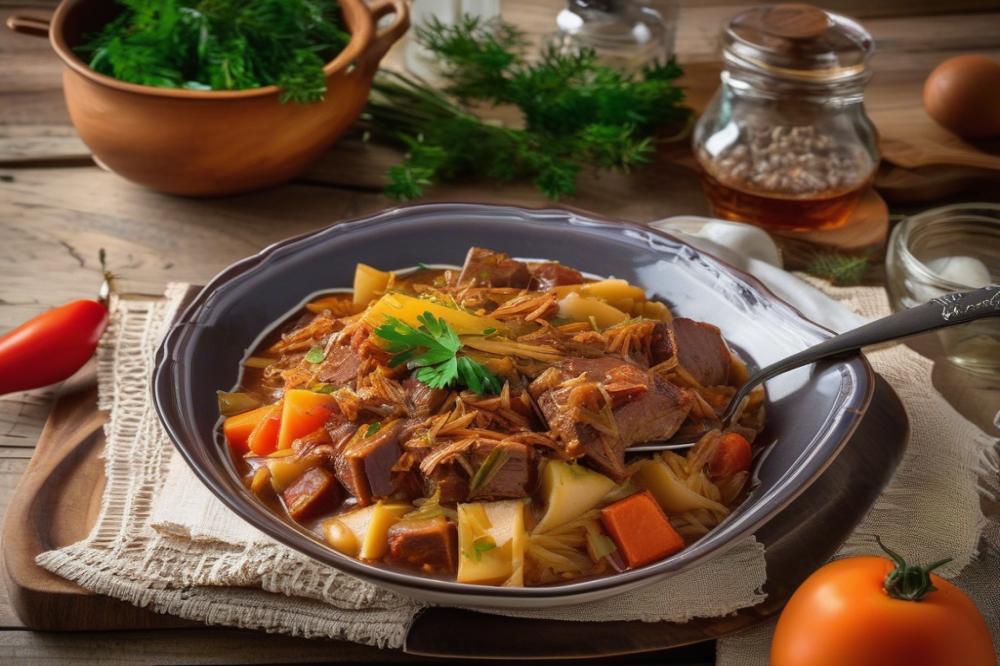
Preparing the Polish hunter’s stew is quite simple, yet fulfilling. Start by gathering all your essential ingredients. You’ll need sauerkraut, different types of meat, and some spices. The choice of meat can vary. Common options include pork, beef, and even sausage.
Begin by rinsing the fermented cabbage under cold water. This step helps to control the acidity of the sauerkraut. Once that’s done, slice your meats into bite-sized pieces. For added flavor, consider browning the meats in a large pot first. This forms a savory base for the dish.
After browning, remove the meat and set it aside. In the same pot, sauté onions and garlic until they become soft. This adds a depth of flavor that enhances the dish. Next, add the sauerkraut and stir everything together thoroughly.
Slow Cooking for Flavor
Return the browned meat to the pot. Now is the time for all the spices! Use bay leaves, black pepper, and caraway seeds for an authentic taste. Pour in some broth or water to cover the ingredients. A splash of wine can also enrich the flavor. This stew should simmer slowly.
Ideal cooking time ranges from two hours to even a whole day. Don’t rush the process. The longer you cook, the richer the flavors will become. Make sure to stir occasionally. It’s important to check that nothing sticks to the bottom of the pot.
Tips for Best Results
For authentic flavors, prepare your dish a day ahead. This allows the ingredients to meld and develop a deep taste profile. You can also adjust the consistency by adding more broth if necessary. Remember to taste it while cooking. Each tweak can greatly affect your outcome.
If you like your stew with more vegetables, consider adding carrots or mushrooms. Such additions not only enhance the dish but also contribute more nutrition. On colder days, this hearty meal pairs nicely with fresh bread or a side of potatoes.
To store leftovers, cool the stew completely before placing it in containers. This easy recipe keeps well in the refrigerator and flavors will improve as it sits. Reheating it brings comfort and satisfaction, perfect for winter dishes.
Variations of Bigos
Regional Variations within Poland
In Poland, you can find many interpretations of this comforting dish. Each region has its own twist on preparing hunter’s stew. In the north, people might use smoked fish, adding a different dimension to the flavor. Conversely, in the south, wild game like venison or boar is more common. This showcases the local ingredients available, which greatly influences the taste. Some towns prepare it with more mushrooms, while others enjoy a heartier mix of meats. Exploring these regional variations adds to the dish’s rich heritage.
Alternative Meats and Vegetables
Different types of meat can transform the stew into something new. Beyond pork and beef, one can experiment with chicken or turkey for a lighter version. Even sausage selections vary widely. Polish kielbasa is a famous choice, but any robust sausage will enhance the flavor. Additionally, adding root vegetables, such as carrots and potatoes, can make the dish even more satisfying. Each ingredient contributes its character, creating a stew that can fit personal tastes.
Vegetarian and Vegan Adaptations
Not everyone eats meat, but everyone can enjoy this delicious meal. For a vegetarian option, use a mix of mushrooms and beans to create richness. Sauerkraut provides that familiar tang, while hearty veggies like bell peppers and squash give bulk. A vegan adaptation can substitute vegetable broth for meat, ensuring the dish remains flavorful. The fermented cabbage brings the traditional taste that many love, allowing everyone to savor a big bowl of comfort food, regardless of dietary preferences. Ultimately, these adaptations show that traditional recipes can evolve without losing their essence.
Enjoying Bigos
Traditional serving suggestions and pairings
Serving hunter’s stew is about comfort and satisfaction. This dish shines when paired with hearty bread. A fresh rye or a crusty sourdough complements the flavors beautifully. Some people enjoy a dollop of sour cream on top, which can balance the richness of the meat. A sprinkle of fresh parsley adds a nice touch, making the presentation as delightful as the taste. Many also like to serve it alongside steamed potatoes or dumplings, enhancing the meal’s heartiness. Polish cuisine offers a variety of sides, but nothing quite matches the warmth of a simple salad made with beets.
Perfect occasions and seasons for serving hunter’s stew
Winter months are the ideal time for this dish. Cold weather begs for warm, satisfying meals. Celebrations, family gatherings, or cozy nights with friends all suit this slow-cooked creation. It brings people together, filling the house with rich aromas that remind everyone of home. Festivals and holiday dinners often feature traditional recipes, and a batch of this stew can easily feed a crowd. Don’t forget, it’s also perfect for casual weeknight dinners when you want something hearty after a long day.
Tips for storing and reheating leftovers
Leftovers from this dish can be a delight, as flavors deepen over time. Store any excess in an airtight container in the fridge. Properly preserved, it can last for up to three days. For longer storage, consider freezing portions. When reheating, a slow simmer over low heat works best. This method keeps the meat tender and the sauerkraut flavorful. Stir occasionally and add a splash of water or broth if it seems too thick. Many people find that reheated portions taste even better than the first serving, so don’t hesitate to indulge.
Embracing the Heart of Polish Cuisine
Bigos holds a special place in Polish cuisine. This dish, also known as hunter’s stew, brings together rich flavors and traditional techniques. Families across Poland have cherished this hearty meal for generations. It symbolizes not just nourishment, but also a sense of community and heritage.
Making this stew at home is an adventure worth pursuing. Imagine a pot simmering on your stove, filling your kitchen with the savory scent of meats and sauerkraut. There’s something magical about creating a dish that has a deep history. It connects you to the past while allowing you to share a delightful experience with friends and family.
Exploring traditional recipes opens doors to comfort and joy in our daily lives. These meals remind us of warmth and togetherness. With every bite, we can savor the tradition that these hearty dishes represent. As you consider trying your hand at this stew, remember that cooking can be a way to celebrate culture and create lasting memories.

